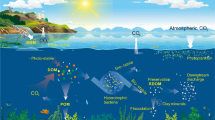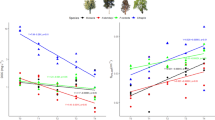Abstract
Following a period of prolonged drought or intentional lake level drawdown, large littoral areas that once contained submersed aquatic vegetation (SAV) are reinundated when lake levels rise. A complete assessment of the contribution made by decomposing SAV to the in-lake phosphorus (P) concentration is important in both the management of Lake Okeechobee and understanding basic P processes. The P contribution to the open waters of Lake Okeechobee from a rapid inundation of exposed SAV was calculated by four methods: cores of field-desiccated SAV, cores of lab-desiccated SAV in the presence and absence of sediments, in situ decomposition, and sequential macrophyte harvesting. P releases, given such an episodic event, were similar among the four methods, ranging from 116±48 to 384±528 mg/m2 in the absence of sediment. When SAV is in contact with sediment, which is the realistic field situation, the amount of P released was four times less (30±14 mg/m2) than in the absence of sediment. The calculated P releases would result in total P concentration increases in the lake from 2 to 15 µg/liter (upper 95% CI=2–25 µg/liter) in the absence of sediment; only 1 µg/liter increase was predicted when SAV released P in contact with sediment. Thus it is unlikely that a significant rise in total P concentrations in the limnetic zone of the lake would occur from the export of P released during the desiccation of SAV in the littoral-marsh zone during a drawdown.
Similar content being viewed by others
Literature Cited
APHA (American Public Health Association). 1985. Standard methods for the examination of water and wastewater, 16th ed. American Public Health Association, 1015 Fifteenth St. NW, Washington, DC 20005.
Boston, H. L., and M. A. Perkins. 1982. Water column impacts of macrophyte decomposition beneath fiberglass screens.Aquatic Botany 14:15–27.
Canfield, D. E., Jr., and M. V. Hoyer. 1988. The eutrophication of Lake Okeechobee.Lake and Reservoir Management 4:91–99.
Carignan, R. 1982. An empirical model to estimate the relative importance of roots in phosphorus uptake by aquatic macrophytes.Canadian Journal of Fisheries and Aquatic Sciences 39:243–247.
Carpenter, S. R. 1980. Enrichment of Lake Wingra, Wisconsin, by submersed macrophyte decay.Ecology 61:1145–1155.
Carpenter, S. R., and M. S. Adams. 1978. Macrophyte control by harvesting and herbicides: Implications for phosphorus cycling in Lake Wingra, Wisconsin.Journal of Aquatic Plant Management 16:20–23.
Davis, C. B., and A. G. van der Valk. 1983. Uptake and release of nutrients by living and decomposingTypha glauca Godr. tissues at Eagle Lake, Iowa.Aquatic Botany 16:75–89.
Dierberg, F. E. 1992. The decomposition of desiccated submersed aquatic vegetation and the bioavailability of released phosphorus.Lake and Reservoir Management (submitted).
Dierberg, F. E., and R. Novy. 1991. Internal phosphorus loading in Lake Okeechobee: Littoral zone characteristics and associated biochemical processes. Final report submitted to the South Florida Water Management District. Department of Oceanography/Ocean Engineering/Environmental Science, Florida Institute of Technology, Melbourne, Florida.
Gopal, B., and K. P. Sharma. 1984. Seasonal changes in concentration of major nutrient elements in the rhizomes and leaves ofTypha elephantina Roxb.Aquatic Botany 20:65–73.
Hach, C. C., S. V. Brayton, and A. B. Kopelove. 1985. A powerful Kjeldahl nitrogen method using peroxymonosulfuric acid.Journal of Agricultural and Food Chemistry 33:1117–1123.
Howard-Williams, C. 1985. Cycling and retention of nitrogen and phosphorus in wetlands: A theoretical and applied perspective.Freshwater Biology 15:391–431.
Howard-Williams, C., and B. R. Allanson. 1981. Phosphorus cycling in a densePotamogeton pectinatus L. bed.Oecologia 49:56–66.
Landers, D. H. 1981. Effects of naturally senescing aquatic macrophytes on nutrient chemistry and chlorophylla of surrounding waters.Limnology and Oceanography 27:428–439.
LOLZTG. 1988. Assessment of emergency conditions in Lake Okeechobee littoral zone: Recommendations for interim management. Report submitted to the South Florida Water Management District by Lake Okeechobee Littoral Zone Technical Group, West Palm Beach, Florida.
Maceina, M. J., and D. M. Soballe. 1989. Lake watch report—1988: The status of algal blooms on Lake Okeechobee in 1988. South Florida Water Management District Technical Memorandum. December 1989. South Florida Water Management District, West Palm Beach, Florida.
Maceina, M. J., and D. M. Soballe. 1990. Wind-related limnological variation in Lake Okeechobee, Florida.Lake and Reservoir Management 6:93–100.
Morris, J. T., and K. Lajtha. 1986. Decomposition and nutrient dynamics of litter from four species of freshwater emergent macrophytes.Hydrobiologia 131:215–223.
Nichols, D. S., and D. R. Keeney. 1973. Nitrogen and phosphorus release from decaying water milfoil.Hydrobiologia 42:509–525.
Prentki, R. T., T. D. Gustafson, and M. S. Adams. 1978. Nutrient movements in lakeshore marshes. Pages 169–194in R. E. Good, D. F. Whigham, and R. L. Simpson (eds.), Freshwater wetlands. Ecological processes and management potential. Academic Press, New York.
Prentki, R. T., M. S. Adams, S. R. Carpenter, A. Gasith, C. S. Smith, and P. R. Weiler. 1979. The role of submersed weedbeds in internal loading and interception of allochthonous material in Lake Wingra, Wisconsin, USA.Archiv für Hydrobiologie, Supplement 57:221–250.
Schardt, J. D., and L. E. Nall. 1988. The 1988 Florida aquatic plant survey. Technical report 89-CGA. Florida Department of Natural Resources, Bureau of Aquatic Plant Management, Tallahassee, Florida.
Smith, C. S., and M. S. Adams. 1986. Phosphorus transfer from sediments byMyriophyllum spicatum.Limnology and Oceanography 31:1312–1321.
Twilley, R. R., G. Ejdung, P. Romare, and W. M. Kemp. 1986. A comparative study of decomposition, oxygen consumption and nutrient release for selected aquatic plants occurring in an estuarine environment.Oikos 47:190–198.
Wallsten, M., and P.-O. Forsgren. 1989. The effects of increased water level on aquatic macrophytes.Journal of Aquatic Plant Management 27:32–37.
Welch, E. B., and T. S. Kelly. 1990. Internal phosphorus loading and macrophytes: An alternative hypothesis.Lake and Reservoir Management 6:43–48.
van der Valk, A. G. 1981. Succession in wetlands: A Gleasonian approach.Ecology 62:688–696.
van der Valk, A. G. 1987. Vegetation dynamics of freshwater wetlands: A selected review of the literature.Archiv für Hydrobiologie Beihefte 27:27–39.
Author information
Authors and Affiliations
Rights and permissions
About this article
Cite this article
Dierberg, F.E. The littoral zone of lake okeechobee as a source of phosphorus after drawdown. Environmental Management 16, 371–380 (1992). https://doi.org/10.1007/BF02400076
Issue Date:
DOI: https://doi.org/10.1007/BF02400076




